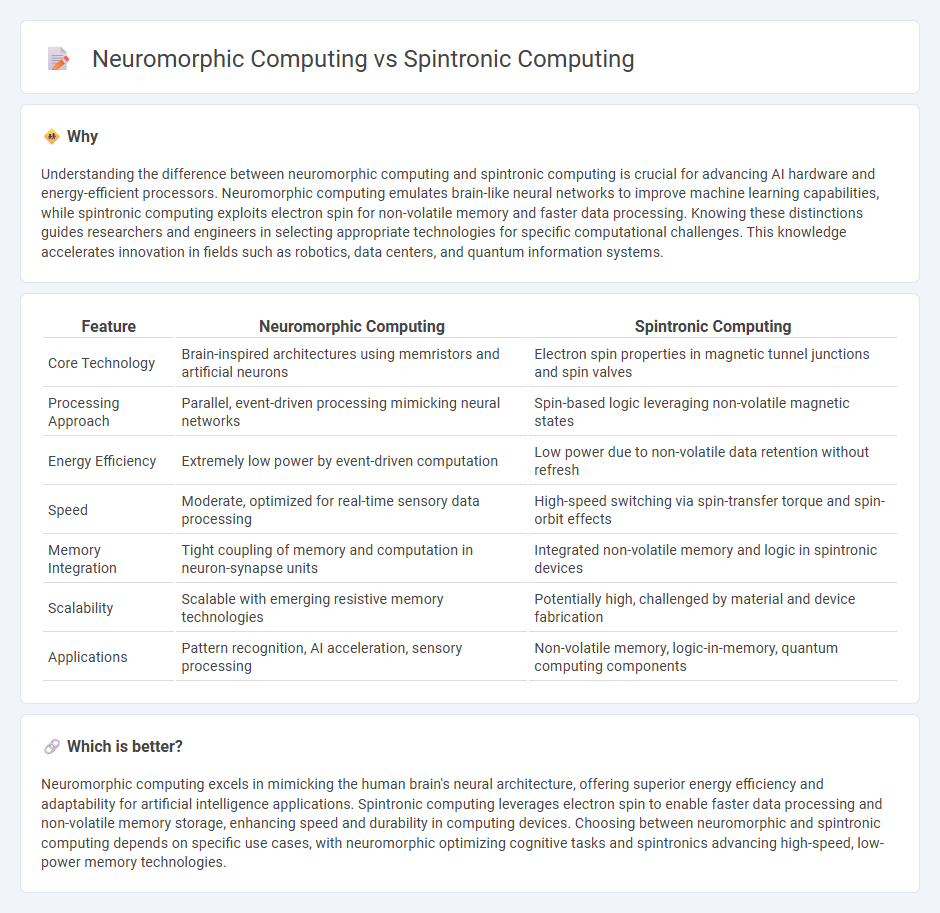
Neuromorphic computing mimics the human brain's neural architecture using artificial synapses and neurons to achieve energy-efficient processing, while spintronic computing exploits electron spin and magnetic states to enable faster, non-volatile memory and logic devices. Both technologies aim to overcome limitations of traditional silicon-based systems, offering breakthroughs in speed, energy efficiency, and scalability for AI and data-intensive applications. Explore the latest advancements in neuromorphic and spintronic computing to understand their transformative impact on future technology.
Why it is important
Understanding the difference between neuromorphic computing and spintronic computing is crucial for advancing AI hardware and energy-efficient processors. Neuromorphic computing emulates brain-like neural networks to improve machine learning capabilities, while spintronic computing exploits electron spin for non-volatile memory and faster data processing. Knowing these distinctions guides researchers and engineers in selecting appropriate technologies for specific computational challenges. This knowledge accelerates innovation in fields such as robotics, data centers, and quantum information systems.
Comparison Table
| Feature | Neuromorphic Computing | Spintronic Computing |
|---|---|---|
| Core Technology | Brain-inspired architectures using memristors and artificial neurons | Electron spin properties in magnetic tunnel junctions and spin valves |
| Processing Approach | Parallel, event-driven processing mimicking neural networks | Spin-based logic leveraging non-volatile magnetic states |
| Energy Efficiency | Extremely low power by event-driven computation | Low power due to non-volatile data retention without refresh |
| Speed | Moderate, optimized for real-time sensory data processing | High-speed switching via spin-transfer torque and spin-orbit effects |
| Memory Integration | Tight coupling of memory and computation in neuron-synapse units | Integrated non-volatile memory and logic in spintronic devices |
| Scalability | Scalable with emerging resistive memory technologies | Potentially high, challenged by material and device fabrication |
| Applications | Pattern recognition, AI acceleration, sensory processing | Non-volatile memory, logic-in-memory, quantum computing components |
Which is better?
Neuromorphic computing excels in mimicking the human brain's neural architecture, offering superior energy efficiency and adaptability for artificial intelligence applications. Spintronic computing leverages electron spin to enable faster data processing and non-volatile memory storage, enhancing speed and durability in computing devices. Choosing between neuromorphic and spintronic computing depends on specific use cases, with neuromorphic optimizing cognitive tasks and spintronics advancing high-speed, low-power memory technologies.
Connection
Neuromorphic computing and spintronic computing intersect through their shared aim of mimicking neural processes using advanced hardware to enhance computational efficiency. Neuromorphic systems leverage spintronic devices like magnetic tunnel junctions (MTJs) for their non-volatile memory and ultra-low power consumption, enabling the emulation of synaptic functions. Research in spintronics advances the development of brain-inspired architectures by providing scalable, energy-efficient components vital for real-time processing in neuromorphic platforms.
Key Terms
Spintronic Computing:
Spintronic computing leverages the intrinsic spin of electrons, alongside their charge, to perform data processing and storage with significantly reduced energy consumption and faster switching speeds compared to traditional semiconductor devices. This technology enables non-volatile memory integration directly within logic circuits, enhancing computational efficiency and scalability. Explore the potential of spintronic computing to revolutionize next-generation information processing systems.
Spin Valve
Spin valve technology in spintronic computing leverages electron spin to achieve non-volatile memory and logic operations with ultra-low power consumption, enabling faster and more energy-efficient data processing compared to traditional charge-based devices. Neuromorphic computing mimics the brain's neural architecture for advanced pattern recognition and learning capabilities, often utilizing memristors and other resistive switching elements rather than spin valves. Explore deeper insights into how spin valve-based spintronic devices compare with neuromorphic systems for next-generation computing solutions.
Magnetoresistance
Spintronic computing leverages magnetoresistance effects such as tunneling magnetoresistance (TMR) and giant magnetoresistance (GMR) to enable high-density, low-power, and non-volatile memory elements, enhancing data storage and logic integration. Neuromorphic computing uses magnetoresistance primarily in spintronic synapses and neurons to mimic biological neural networks, emphasizing energy efficiency and real-time learning capabilities. Explore the intricate roles of magnetoresistance in both computing paradigms to understand their potential and advancements.
Source and External Links
Spintronics for Neuromorphic Computing - This approach uses spintronic circuits to create energy-efficient computing systems, leveraging magnetic tunnel junctions for complex neuromorphic applications.
Spintronic Devices for Energy-efficient Computation - This video explores how spintronics offers a paradigm shift in computing by utilizing magnetic materials and electron spin for highly efficient memory and switching devices.
Spintronics for Neuromorphic Computing | NIST - NIST is investigating spintronics as a promising approach for next-generation computing by leveraging magnetic tunnel junctions to mimic brain-like activity.
 dowidth.com
dowidth.com